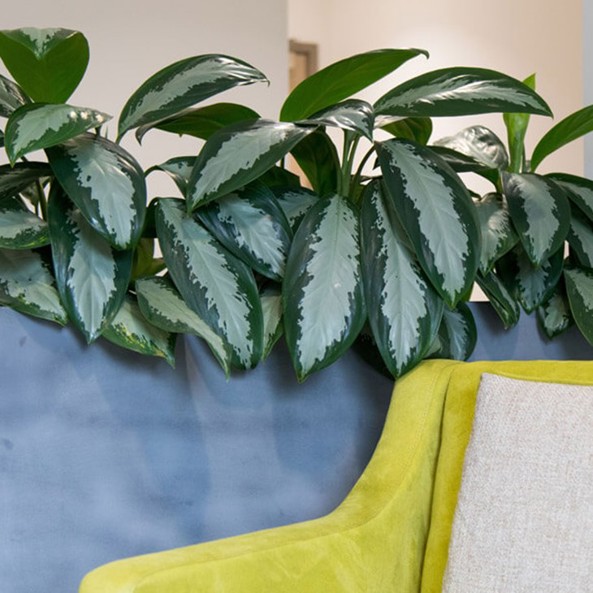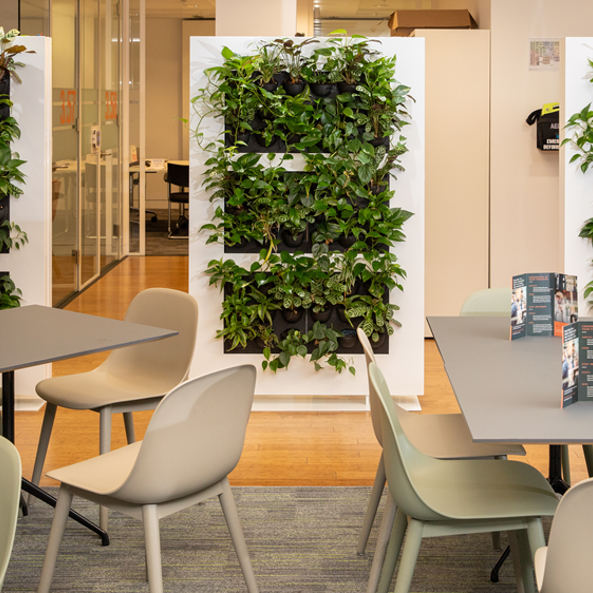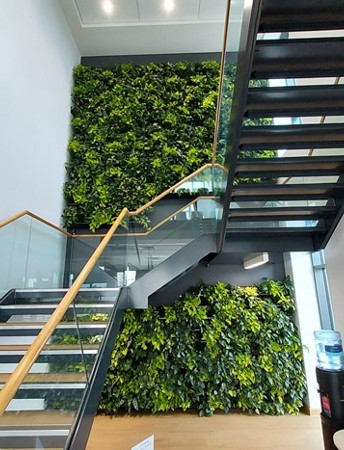Many of us love plants and colours for their ability to add colour and interest to a space, making them the perfect way of making offices, hospitals, educational facilities, restaurants and other public spaces feel more inviting.
However, a human’s love of plants extends far beyond their pretty appearance; it’s actually something that’s always been ingrained in us. Not only that, but countless studies have proven the health benefits of plants, both in terms of our physical health and mental health.
Biophilia is the term used to describe the connection humans feel with nature, as well as our biological need to remain in close contact with it. Made popular by the psychologist, Erich Fromm, who first used the term in The Anatomy of Human Destructiveness in 1964, it’s now most commonly used to describe natural elements being incorporated into interior design, and how they can improve our health, mood, and overall productivity. These include natural materials, exposure to natural light, and of course, the introduction of plenty of luscious indoor plants!
As we’ve already explained, the reason that ‘biophilic’ design is becoming so popular in both the home and public spaces is because of their effect on our health and happiness. Plants improve the quality of the air we breathe, improving many areas of our lives by boosting our cognitive function, and reducing anxiety and stress levels. They also promote healing, and they can even stop you from getting ill in the first place.
Here are just some of the main health benefits of plants and why they can be a great addition to your office, restaurant or any other environment you work in…
They Purify The Air
High levels of carbon dioxide (CO2), dust, mould and bacteria in the air can cause people to feel unwell, leading to headaches, nausea, sore throats and dry eyes. Dust mites and mould spores are also known triggers for asthma attacks, and 1 in 3 people are actually allergic to mould. Fortunately, interior plants are effective at removing CO2, dust, mould and bacteria from the air, with Flowers24Hours explaining, “flowers clean the air inside your home and in any closed indoor space with either poor ventilation or less than optimal circulation – such as an office, lobby, or reception area.” As a matter of fact, research has found that plants can reduce CO2 levels by about 10% in air-conditioned offices, and by about 25% in buildings without air conditioning.
They Humidify The Air
Another benefit of interior plants is that they raise the humidity levels in a room. This means that they stop the air from becoming very dry (particularly in winter when heaters are being used), which causes dry skin and eyes, an irritated throat and sinuses, and even dehydration in some cases. Dry air can also aggregate conditions such as asthma and allergies, and because it dries out the mucus membrane that lines our respiratory tracts, it can encourage the spread of colds, flu and infections. This increases the amount of sickness leave being taken in offices, and reduces healing times for hospital patients.

They Combat Sick Building Syndrome
Sick Building Syndrome (SBS) describes the unpleasant symptoms people experience when they spend an extended period of time in the same building, with educational facilities, hospitals and offices being the main culprits. These symptoms include headaches, a blocked or runny nose, rashes, itchy skin and sore eyes. SBS is theorised to be caused by poor ventilation and frequent exposure to everyday toxins, such as Benzene, Trichloroethylene, Xylene, and Formaldehyde.
These everyday toxins are found in many items that people come into contact with in offices, hospitals and schools, such as paints, printing inks, window cleaners, paper towels, paper bags and facial tissues. In the late 1980s, NASA conducted their Clean Air study to find the best plants to clean the air in space stations, finding that a number of plants were effective at purifying the air of these toxins.
They Improve Productivity
There are a number of studies that prove that the addition of plants in schools and offices can increase our academic performance, and thus, our productivity levels. According to findings from the University of Michigan, being in the presence of plants can increase memory retention by up to 20%. Additionally, a study from Washington State University discovered that subjects were more productive when plants were placed around the room, as their reactions when completing a computer task were 12% quicker.
One of the reasons that plants improve productivity is theorised to be because of their ability to reduce distracting background noise in buildings, including outside traffic and general chatter. Different parts of the plant, such as the stems, leaves and branches absorb sound, with fleshly leaves bring particularly effective due to their dynamic surface area.
They Make Us Happier
The biophilic effect of plants has been backed by a number of studies, with a particular example being research conducted by the new University of Technology, Sydney (UTS) in 2010. They found that when plants were introduced to the workplace, employees reported that anxiety and tension levels reduced by 37%, dejection reduced by 58%, and anger and hostility reduced by 44%. This study also found that office plants decreased fatigue levels by 38%. These are all factors that can have a considerable impact on our mood and well-being, both in the home and the workplace.
They Help Us Sleep
Another way that plants can improve our general well-being is by helping us sleep when they’re placed in the bedroom. This is because certain plants (such as eucalyptus) emit compounds that have various health benefits, including reducing insomnia. As well as making you more irritable the next day, a lack of sleep can have a negative effect on our health. Long-term sleep debt could lead to the development of depression, anxiety and other long-term mood disorders, heart disease and high blood pressure. A consistent lack of sleep may also lead to type 2 diabetes.
They Promote Healing
Research by environmental psychologist, Roger Ulrich, and his team discovered that patients who had gallbladder surgery healed faster if they were placed near windows that overlooked trees. By looking at the medical records of the patients (who underwent their surgery at a Pennsylvanian hospital), they found that those with a view of trees also needed less pain medication, and they also experienced less post-surgical complications. This could be because plants reduce stress, and stress has been shown to slow the healing process due to the interference of Cortisol (the stress hormone).

The Best Plants For Corporate And Commercial Environments
To Remove Everyday Toxins From The Air
Although many indoor plants can improve the quality of the air we breathe, tests by the University of Georgia has concluded that English Ivy (Hedera helix) is particularly effective at absorbing the everyday toxins that are emitted by computers, printers and other electrical machinery found in office buildings. Fortunately, this plant is also easy to look after as it doesn’t like its soil to be too wet, and it only needs a moderate amount of sunlight.
To Improve Your Staff Or Student’s Moods
According to an Ohio State University study, the smell of lemon oil is a mood enhancer, making Lemon Balm a great plant to put in schools, hospitals, offices, and even your home! Even if you’re lacking time or green fingers, Lemon Balm is an ideal option as it’s one of the easiest plants to care for. It thrives in both sunlight and full shade, so place it in a window, in the corner of a room, on top of a bookshelf, or pretty much anywhere you like!
To Absorb Noise In Busy Environments
Weeping Fig (ficus benjamina) is known for its pointed patterned leaves, but thanks to their thickness, it’s one of the best plants for absorbing pollutants and reducing sound levels in bustling environments. Weeping figs like sunlight, though they don’t like to be moved after they’ve become accustomed to a spot. With that in mind, place them in a partially shaded part of the room, and make sure none of your employees try to be kind by giving it a change of scenery.

At phs Greenleaf, we’re passionate about plants and the various benefits they can bring. This is why we have over 25 years of experience of providing indoor and outdoor planting services to businesses across the UK, from cosy pubs and restaurants, to corporate offices. To find out more about how we can transform your workplace with flowers, contact us today.




































